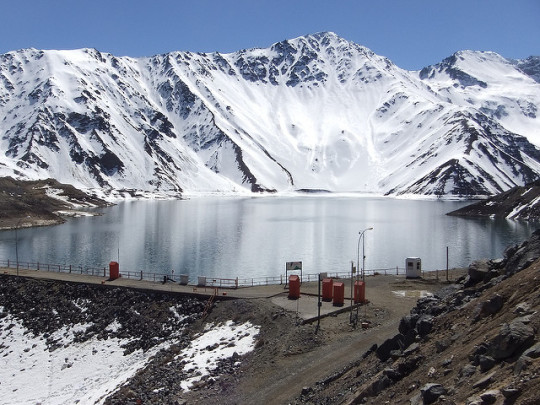Drought Continuous in Chile, Heat Increases

By Alana Gale
photo “Embalse” by Christian Córdova under Creative Commons License
27 May 2016. Santiago, Chile. Last week we wrote an article focusing on how El Niño controls weather patterns in Chile. This week, we take a look at how increased heat—which may be an effect of El Niño—is influencing the lives of the Chilean people.
A small weather data sample has shown that this autumn and this spring in Chile have been hotter than previous years. For instance, was 1°C warmer than . Likewise, the average mean temperature was 2°C higher than .
So what are the consequences of these rising temperatures for Chile?
The “Mega-drought”
Despite the fact that El Niño brings more rainfall to some areas in Chile, there are still many regions not getting enough rain. In fact, twelve of the 22 weather stations for the Chilean Management of Meteorology reported a deficit in precipitation.
This has led to the longest and most extensive drought in Chilean history. And the hotter weather is only making the drought worse.
The drought, which has been called the “megasequía” in Spanish (“mega-drought”), has gone on in some zones for over six years. It also covers seven regions of the country, stretching from Coquimbo to La Araucanía.
The continuation of the drought is especially unfortunate for farmers. The president of the National Agricultural Society told El Mercurio that farmers depend on rain, and when it doesn’t rain for 30 or 40 days, the crops are in danger. He added that the damage to potatoes, wheat, oats, and barley has been irreversible.
In fact, some farmers in Coquimbo and Ovalle have even abandoned their farms because of the drought. They moved to the city to find jobs there, instead.
The Higher Risk of Forest Fires
Another consequence of the drought is a bigger threat of forest fires. The region of Araucania has been in a drought for several years. So there is a higher chance that forest fires will occur in three of Chile’s national parks: China Muerta National Reserve, Nalca Lolco National Reserve, and Conguillio National Park.
Last year President Bachelet issued a national alert because of these fires. She said that she would invest millions of dollars to improve access to underground water and to build more plants to filter water so that it is drinkable. But the drought continues.
Chile’s Depleting Water Reservoirs
Also related to the drought is the decreasing amount of water in Chile’s reservoirs. According to the General Management of Water in Chile, the reservoirs in Chile are only filled to 35% of their capacity.
Although the region of Coquimbo has more water in the reservoirs than it did last year, other regions, like Puclaro, Cogotí, La Paloma and Recoleta are still filled to less than half of their full capacity. And these are the biggest regions in the country.
The main reservoir for the region Biobío is Lake Laja, and it has a 66.8% deficit. José Luis Arumí, a hydrologist at the University of Concepción, said that the reservoir would need twenty years to refill.
But it has little chance of refilling if La Niña strikes. We noted last week that if La Niña comes, the drought might intensify further.



